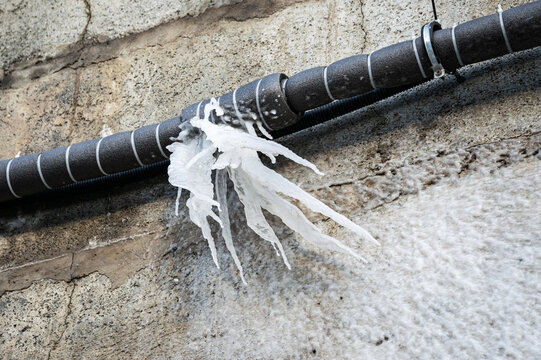This article down the page relating to Prevent Frozen Pipes is rather insightful. Read it for yourself and figure out what you think about it.

Cold weather can ruin your pipes, specifically by freezing pipelines. Right here's just how to avoid it from happening and what to do if it does.
Introduction
As temperature levels drop, the risk of frozen pipes rises, potentially bring about pricey repairs and water damages. Recognizing how to stop frozen pipelines is crucial for homeowners in chilly environments.
Understanding Icy Pipes
What creates pipelines to ice up?
Pipes ice up when revealed to temperatures listed below 32 ° F (0 ° C) for prolonged periods. As water inside the pipelines ices up, it increases, taxing the pipe walls and possibly creating them to rupture.
Risks and problems
Frozen pipelines can cause water supply disruptions, residential property damage, and expensive repair services. Burst pipelines can flood homes and cause substantial architectural damage.
Signs of Frozen Pipeline
Recognizing frozen pipes early can prevent them from rupturing.
How to determine icy pipes
Search for lowered water flow from taps, unusual smells or sounds from pipes, and noticeable frost on revealed pipes.
Prevention Tips
Insulating at risk pipes
Wrap pipelines in insulation sleeves or make use of warmth tape to secure them from freezing temperature levels. Concentrate on pipes in unheated or external areas of the home.
Home heating techniques
Keep indoor rooms effectively heated, specifically areas with pipes. Open closet doors to allow warm air to distribute around pipes under sinks.
Securing Outside Pipes
Garden pipes and exterior taps
Separate and drain yard hoses before winter. Set up frost-proof faucets or cover exterior faucets with insulated caps.
What to Do If Your Pipelines Freeze
Immediate activities to take
If you presume frozen pipes, keep taps open up to relieve pressure as the ice melts. Make use of a hairdryer or towels soaked in hot water to thaw pipes slowly.
Long-Term Solutions
Structural modifications
Think about rerouting pipes away from exterior wall surfaces or unheated locations. Include added insulation to attic rooms, basements, and crawl spaces.
Updating insulation
Purchase high-quality insulation for pipelines, attic rooms, and walls. Proper insulation aids maintain regular temperature levels and minimizes the danger of icy pipelines.
Conclusion
Avoiding icy pipes calls for positive measures and fast reactions. By understanding the reasons, indications, and safety nets, house owners can secure their pipes throughout winter.
6 Proven Ways to Prevent Frozen Pipes and Protect Your Home
Disconnect and Drain Garden Hoses
Before winter arrives, start by disconnecting your garden hoses and draining any remaining water. Close the shut-off valves that supply outdoor hose bibs and leave the outdoor faucet open to allow any residual water to drain. For extra protection, consider using faucet covers throughout the colder months. It’s also important to drain water from any sprinkler supply lines following the manufacturer’s directions.
Insulate Exposed Pipes
Insulating your pipes is an effective way to prevent freezing. Pipe insulation is readily available at home improvement stores and is relatively inexpensive. Pay close attention to pipes in unheated areas such as the attic, basement, crawl spaces, or garage. Apply foam insulation generously to create a buffer against the cold. You can also wrap your pipes in heat tape or thermostat-controlled heat cables for added warmth.
Seal Air Leaks
Inspect your home for any cracks or openings that could let in cold air. Seal any holes around the piping in interior or exterior walls, as well as the sill plates where your home rests on its foundation. Additionally, make sure to keep your garage door closed unless you’re entering or exiting. Leaving it open creates a significant air leak that can lead to frozen pipes.
Allow Warm Air Circulation
During cold snaps, it’s essential to allow warm air to circulate evenly throughout your home. Leave interior doors ajar to promote better airflow. Open kitchen and bathroom cabinets to help distribute heat consistently around the rooms. If you have small children or pets, be sure to remove any household chemicals or potentially harmful cleaners from open cabinets for safety.
Let Faucets Drip
A small trickle of water can make a big difference in preventing ice formation inside your pipes. When temperatures drop significantly, start a drip of water from all faucets served by exposed pipes. This continuous flow helps prevent the water from freezing. Additionally, running a few faucets slightly can relieve pressure inside the pipes, reducing the chances of a rupture if the water inside does freeze.
https://choateshvac.com/6-proven-ways-to-prevent-frozen-pipes-and-protect-your-home/

As a devoted person who reads about How to prepare your home plumbing for winter weather, I imagined sharing that excerpt was a smart idea. Appreciated our blog posting? Please quickly share it. Let other people discover it. We appreciate your readership.
Click Here